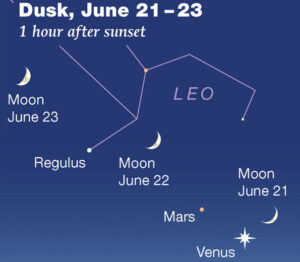Special to CosmicTribune.com, June 25, 2023
■ This is the time of year when, after dark, the dim Little Dipper floats straight up from Polaris, the end of its handle.

WEDNESDAY JUNE 21
■ Look west at dusk for the waxing crescent Moon beautifully paired with bright white Venus, as shown below. Catch Mars and Regulus as twilight deepens.
Venus and the Moon tonight are only about 3° apart at the times of dusk in the Americas. And little Mars makes three.
■ Welcome summer! The solstice arrives today at 10:58 a.m. EDT. This is when the Sun is farthest north for the year in Earth’s sky and begins its six-month return southward. Summer officially begins in the Northern Hemisphere, winter in the Southern Hemisphere.
For us northerners, this is the year’s longest day and shortest night.
It’s also the day when (in the north temperate latitudes) the midday Sun passes the closest it ever can to being straight overhead.
THURSDAY, JUNE 22
■ Now the Moon forms a line with Mars and Venus to its lower right, as shown above. And catch Regulus. At magnitude 1.3 it outshines Mars at mag 1.7.
FRIDAY, JUNE 23
■ This is the time of year when the two brightest stars of summer, Arcturus and Vega, are about equally high overhead shortly after dark: Arcturus toward the southwest, Vega toward the east.
Arcturus and Vega are 37 and 25 light-years away, respectively. They represent the two commonest types of naked-eye star: Arcturus is a yellow-orange K giant, and Vega is a white A main-sequence star. They’re 150 and 50 times brighter than the Sun, respectively — which, combined with their nearness, is why they dominate the sky.
SATURDAY, JUNE 24
■ The Moon, nearly first quarter, shines after dark about a fist-width under Denebola, Leo’s tail-tip star.
SUNDAY, JUNE 25
■ First-quarter Moon tonight (exactly first-quarter at 3:50 a.m. Monday morning EDT).

You must be logged in to post a comment Login